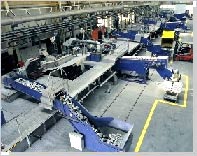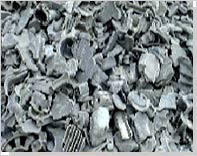 The eighth most abundant element on the planet, magnesium constitutes about 2 % of the Earth's crust. In seawater, it is the third most plentiful element with an average concentration of 0.13 %. Though the metal is found in more than 60 minerals, carnallite, brucite, dolomite, magnesite, and olivine are of commercial importance. The metals is produced from seawater, lake brines and well, and bitterns, as well as from the minerals dolomite, carnallite, and magnesite.
The eighth most abundant element on the planet, magnesium constitutes about 2 % of the Earth's crust. In seawater, it is the third most plentiful element with an average concentration of 0.13 %. Though the metal is found in more than 60 minerals, carnallite, brucite, dolomite, magnesite, and olivine are of commercial importance. The metals is produced from seawater, lake brines and well, and bitterns, as well as from the minerals dolomite, carnallite, and magnesite.
Major production centers of primary magnesium include - Brazil, Canada, China, France, Israel, India, Norway, Kazakhstan, Russia, Serbia and Montenegro, Ukraine, and the United States.
Sources of Magnesium Scrap Sources of Magnesium Scrap New magnesium-base scrap can be generally categorized into four types. Type I is a high-grade scrap, which generally include materials, such as runners, gates, and drippings from die casting operations, which is uncontaminated with oils. Types II, III, and IV are lower grade materials in which type II is oil-contaminated scrap, type III is dross from magnesium-processing operations, and type IV is fines and chips.
Sources of Magnesium Scrap New magnesium-base scrap can be generally categorized into four types. Type I is a high-grade scrap, which generally include materials, such as runners, gates, and drippings from die casting operations, which is uncontaminated with oils. Types II, III, and IV are lower grade materials in which type II is oil-contaminated scrap, type III is dross from magnesium-processing operations, and type IV is fines and chips.
The most desirable of these different types of scraps is type I, which is generated during die casting magnesium alloys. This scrap is either sold to a scrap processor or reprocessed at the die casting facility. The other types of scraps are either sold to a scrap processor or are utilized directly in steel desulfurization that is a dissipative application. Old magnesium-base scrap, or post consumer scrap comprises materials, such as helicopter parts, automotive parts, used tools, lawnmower decks, and the like. Scrap processors buy this scrap.
In addition to the magnesium-base scrap, considerable quantities of magnesium are incorporated in aluminum alloys, which can also be recycled. Although some magnesium is lost in the processing of scrap, a substantial quantity of the magnesium metal is recycled with aluminum alloy. New aluminum-base scrap, which is recycled, contains, in decreasing order of importance - primarily of solids, turnings and borings, dross and skimmings, and other materials that include foil and can-stock clippings. Because the primary aluminum product, which contains magnesium is beverage cans, the major magnesium-containing, aluminum-base scrap is can scrap skeleton obtained from lids and can sheet clippings. This corresponds to about 1/2 of the overall magnesium-containing, aluminum-base scrap.
Old aluminum-base scrap consists many materials, however the principal magnesium-containing component is used aluminum beverage cans (UBC's). Due to the high recycling rate, aluminum beverage cans represent about three - quarters of the magnesium-containing, old aluminum-base scrap, which is reprocessed. The magnesium in old and new aluminum-base scrap is not separated from the aluminum alloy when it is recycled; instead, it is kept back as an alloying component. Therefore, the magnesium recycling industry depends on three primary components-UBC's, old and new magnesium-base scrap, and new aluminum base scrap.
Types / GradesDifferent types / grades of magnesium scrap that are used to recover pure magnesium by recycling are
|
Recycling Efficiency
Majority of the magnesium scrap, which is recycled comes from aluminum beverage cans (UBC's). This is due to the fact that UBC's have a well-established collection mechanism, which reaches directly to the consumer; some municipalities collect cans at the curbside, thereby making recycling convenient. High recycling rate can be achieved by making recycling easy for the consumer. Most of the magnesium components, which are not recycled, however, are not recycled due to the reason that they are used in consumer goods, which do not have a well-established recycling collection mechanism.
Many items, such as hand tools, are discarded in landfills at the end of their useful life. In cases, wherein the magnesium component is a part of a larger item, like an automobile, the magnesium part may not be separated when the item is recycled, as it represents an insignificant portion of the total weight; hence the magnesium content usually is not recovered during the recycling process. The metal may be oxidized and become entrapped in the dross or fines from recycling and may be discarded.
Another factor, which has a considerable effect on the overall recycling rate is the quantity of magnesium, which is used in dissipative applications that can be defined as uses in which the metal is scattered or dispersed, thereby making it difficult and costly to recycle. This makes it exceptionally difficult and costly to recycle. Magnesium is also consumed in dissipative applications, such as iron and steel de-sulfurization, chemical manufacture, sacrificial anodes, and nodular iron.
Another factor, which has a considerable effect on the overall recycling rate is the quantity of magnesium, which is used in dissipative applications that can be defined as uses in which the metal is scattered or dispersed, thereby making it difficult and costly to recycle. This makes it exceptionally difficult and costly to recycle. Magnesium is also consumed in dissipative applications, such as iron and steel de-sulfurization, chemical manufacture, sacrificial anodes, and nodular iron.
